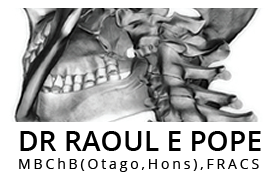Neurosurgery Modalities: An introduction
There are many Modalities for Investigation and Treatment in Neurosurgery. The following pages will provide you with the necessary information concerning the various topics common to Neurosurgery and Dr Pope's practice. It is not intended to be an all-encompassing display of information and acts merely as an introduction. Nothing compares more favourably than a face to face consultation with Dr Pope regarding these Modalities to fully understand their effectiveness and limitations.
Topics include:
Minimally Invasive Spine Surgery (MISS) An alternative approach to the spine to achieve similar surgical goals than conventional techniques, except through tubes and expandable retractors resulting in less tissue damage and increased patient satisfaction, earlier post-op discharge, and earlier return to work times. Dr Pope has a Specialist interest and experience in this evolving technology.
Artificial Discs Cervical and Lumbar spine surgery options. This technology, largely established in Europe as an effective solution to the Motion Preservation Spine Surgery philosophy. Australia is waiting for more FDA Clinical Trials to see the outcomes of more of these devices before they are approved by Medicare and the Health Funds for remuneration. Dr Pope believes in the benefits of these devices and is fully trained in the insertion of the US approved varieties and is a member of the Spine Arthroplasty Society, the leading world society for this technology.
Biodynamic Products Human made or animal derived products that integrate with the human body's own tissues to facilitate the desired outcome. These include Bone Growth Factors for facilitating fusion, and dural substitutes for brain surgery procedures to protect the brain.
Imaging Radiology Investigations such as CT scanning, MRI scanning and CT Myelography. These are important tests used in diagnosis or for screening or following up known or treated conditions. Dr Pope has access to the best facilities at all his hospitals.
Microsurgery The delicate side of Neurosurgery where we utilize powerful eye binoculars (loupes) or operating microscopes to magnify the very tissues we are operating on to minimize risk and complications.
Neuroendoscopy The modality of utilizing an operative camera (endoscope) in a Minimally Invasive fashion to visualise anatomical structures in difficult access locations to enhance outcomes and minimize risk. Dr Pope utilizes this technology for certain cranial procedures and occasionally for some spine cases too.
Neuronavigation Using a technology similar to a global positioning system (GPS), navigation provides the surgeon the ability to see a patient's anatomy in three dimensions and accurately pinpoint a location in the brain or spinal column with the aid of diagnostic images such as computed tomography (CT) and magnetic resonance (MR), or intra-operative X-ray images. Dr Pope has access and uses the most modern Neuronavigation systems at all his hospital appointments.
Neurostimulation is a method of therapy that uses electrical stimulation to cause changes in the nervous system. It is a form of treatment that is mainly used in people who have chronic pain that is not responsive to treatment. Dr Pope provides this service for spinal cord conditions.
Radiosurgery - Stereotactic radiosurgery is a highly precise form of radiation therapy used primarily to treat Tumours and other abnormalities of the brain. Despite its name, stereotactic radiosurgery is a non-surgical procedure that uses highly focused x-rays to treat certain types of Tumours, inoperable lesions and as a post-operative treatment to eliminate any leftover Tumour tissue. Dr Pope's institutions do not provide this service but he can discuss the pros and cons and refer you to highly qualified colleagues who can provide this service.
